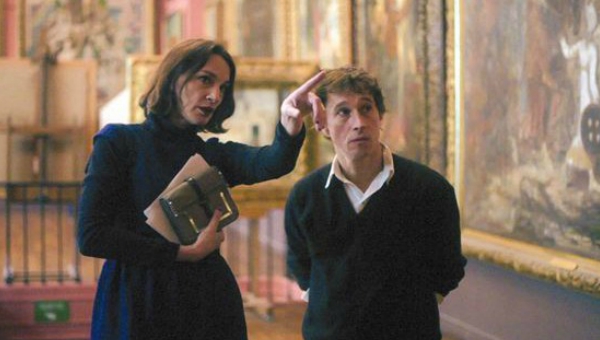French film director Bertrand (Bertrand Bonello), casting around for an artwork to form the centrepiece of his proposed film about a monster, is introduced to the knowledgeable Celia Bhy (Jeanne Balibar) who will serve as his guide round the museums and galleries of Paris. As his partner Barbe (Joana Preiss) prepares to appear in a touring production of Prometheus Bound, Bertrand’s cultural expeditions with Celia take on a flirtatious air. Meanwhile, a large red mark has inexplicably appeared on his back, and appears to be growing…
After an elegantly austere title sequence and a po-faced introductory voice-over (from none other than Charlotte Rampling, one of the many guest performers in the film), the audience may be expecting a series of high-minded encounters with great art. Instead, the mood is considerably lighter and more playful. Indeed, the writer-director Antoine Barraud seems to delight in defying expectations. Throughout the film, for instance, he shows characters looking or listening and delays revealing what is being looked at or listened to — often with great effect, as when Bertrand meets Celia after a short time apart, or when he takes an age setting up a camera shot.
However, the film is also extraordinarily disjointed and more than a little self-indulgent, to an extent which may put off a number of viewers. This may have something to do with the fact that it took five years to make, but is also evidently a deliberate choice on Barraud’s part, whose greater interest seems to be in the theme of metamorphosis, references to which he peppers throughout the film. The scenes in the museums are smart and playful, largely due to Jeanne Balibar’s wonderfully eccentric performance as Celia, but they are only one part of a larger, often chaotic view of Bertrand’s life. Amidst all this noise, the growing red mark on Bertrand’s back (which gives the film its original title, LE DOS ROUGE) appears to be relegated to a minor sub-plot: when Bertrand discusses it with a retired doctor friend (an amusing cameo by the director Barbet Schroeder), the scene plays more like an extended, unconnected sketch than anything else.
… a series of tenuously related sketches, some of which work and some of which don’t …
In fact, for all the magnificence of its supporting cast and the many interesting stylistic choices Barraud makes along the way, the film may almost work better viewed as a series of tenuously related sketches, some of which work and some of which don’t. One improvised sequence, in which Bertrand coaxes bizarrely beautiful music out of something called an Omnichord (an electronic monstrosity from the 1980s) and Barbe improvises a song to it, comes off surprisingly well; a similar singalong scene, during an apparently endless party towards the end of the film, is much less effective — even if, for some reason, Barbe is wearing a fake beard.
The film began as a proposed documentary on Bonello, a director perhaps best known for his film HOUSE OF TOLERANCE (L’Apollonide, 2011), before veering off into something between fiction and reality, and it is typical of the film’s offhand approach that Bonello may or may not be playing a version of himself. His first appearance, standing by Bernini’s Sleeping Hermaphroditus in the Louvre, is almost certainly a sly reference to his film TIRESIA, a modern version of the myth of the prophet Tiresias, who was both man and woman. When an extract from one of ‘Bertrand’s’ works — a stately, overlong riff on Hitchcock’s VERTIGO, that cinematic cornerstone of the theme of metamorphosis — is shown, it is not, strictly speaking one of Bonello’s. (The sequence was indeed directed by Bonello, but specifically for this film.)
httpvh://www.youtube.com/watch?v=ohKoNgQBkws


